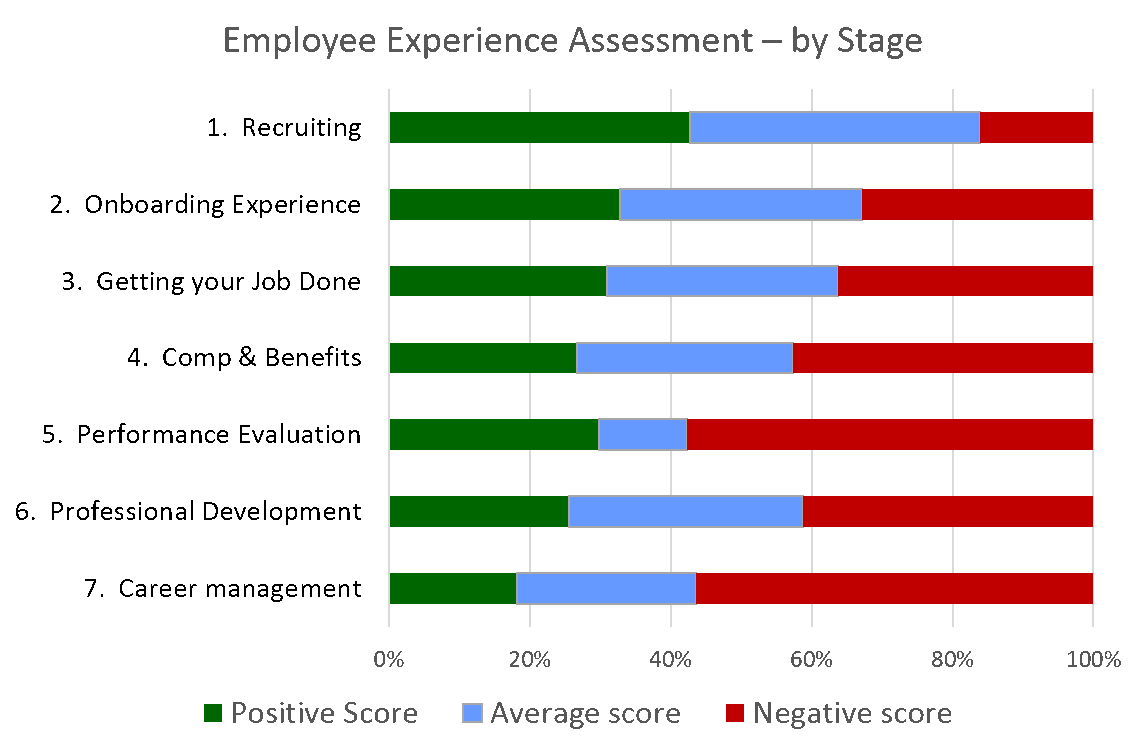For the last 10 years, our company has helped global enterprises and emerging companies rethink their customer experiences to deliver their brand promise. We inevitably discuss how to deliver an employee experience that enables the customer experience – and how to improve employee engagement in today’s hot talent market.
As part of this work, we routinely perform employee journey mapping & design efforts and focus on 30+ employee situations (use cases) that must be designed and consistently executed to deliver an excellent employee experience. Our clients have proven that this experience design leads to higher engagement scores, improved employee retention, productivity, competencies AND enables the target customer experience.
We held focus groups and workshops with hundreds of employees – and saw a number of frequent situations that were handled so poorly that it “made employees want to quit”. We conducted a national US survey and focus group research with employees across more than 400 companies about which situations act as “triggers” to employee attrition or a negative performance impact.
Our research found at every stage of the employee journey, there are one or more situations that directly leads to employee attrition when not properly addressed as an issue or designed to deliver a consistently positive experience. While most companies have strategies, processes and policies for routine compensation and benefits management, organizations don’t have a holistic owner for the many “moments of truth” or critical experiences for employees. Employees are in the hands of operating supervisors and managers – with an uneven quality of delivery and concern for the task at hand – rather than a commitment to support the human that delivers the company’s brand experience.
Our survey approach asked for an assessment of a 37 different components across seven stages of the employee experience. Respondents assessed their company’s performance on a 5-point scale. As you can see, the employee experience starts out with the most positive assessment as an employee enters the company. But as an employee’s career progresses, the experience is rated more negatively and at the career management stage, 58% of our respondents rated it negatively, with only 18% rating it positively.
Six Employee Experiences driving Attrition

Source: Tucker & Company Research, 2017
Within each stage, one or more situations stand out that illuminate the disconnect between a company’s processes and the employee’s desired experience. Here were the six situations that had the worst assessments based on our experience and research.
1. Recruiting stage: Misleading job descriptions – When many prospective employees first see a company, it is through the lens of the job description. An ambitious job design communicates the impact an employee is expected to make, their influence and the first step on a mutually beneficial career with the company. What many employees experience when they start is a limited scope of job responsibilities, functional boundaries on their influence and a minimization of their impact. Many feel they are “bait and switched” in the process.
2. Onboarding stage: Lack of a personalized training plan – When most candidates start they have limited knowledge of the gap between their current capabilities and those needed for the job – or the available resources to help them close the gap. While most felt they would be responsible for the execution of the training plan, the lack of a personalized plan to accelerate their development and performance puzzles them.
3. Job Execution stage: Lack of empowerment – A follow-on to misleading job descriptions, most employees feel that company policies and departmental politics limit their impact. Many feel disempowered to do what’s right for the company or the customer based on departmental rules.
4. Performance Evaluation stage: Punitive or political reward / recognition – Everyone craves performance feedback – they just want it to be objective, developmentally-oriented and fair. When clear standards don’t exist or aren’t used, performance data is collected in a haphazard manner or performance feedback is delivered in a negative tone, a feeling of despair can be created.
5. Professional Development stage: Poor/limited mentoring and informal feedback – Competing inside a company can be a lonely and stressful experience for most employees – and gets worse the higher up you go. Without a trusted mentor and developmental coaching, many employees let the uncertainty and stress impact their performance. What company wouldn’t want their most valuable and tenured employees at their peak performance?
6. Career management stage: Invisibility of internal opportunities – Most employees receive dozens of recruiter emails each week, and see an ocean of external opportunities. But many don’t feel they have the same visibility to internal job opportunities. Stories of job being “hidden internally but posted externally” were common – and many felt their skills weren’t evaluated as objectively or positively as external candidates. Most employees prefer NOT to leave – but feel like the only fair evaluation of their skills will come through the interview process with another company.
By intentionally designing critical “employee experience moments of truth” (the use case scenarios most linked to attrition) companies can not only deliver a consistently excellent experience for both the company and your employees – but employee attrition can be reduced by 50% or more. Your company probably has different “employee experience moments of truth” for your unique employee segments based on employee tenure, industry and business model differences. But every company has an opportunity to improve the employee experience and engagement.



